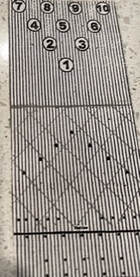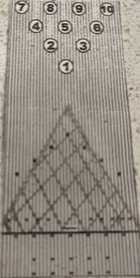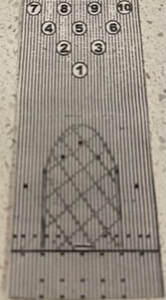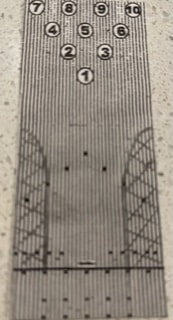|
There are about FOUR GENERAL OIL PATTERNS that will appear on the lanes in league play, and most of them are approximately 40 feet long. Using a 2:1 ratio of moving your feet two boards and your target area 1 board (in the same direction) can help you on these different patterns. Experiment during league practice so you'll be ready when the actual scoring begins.
2. CHRISTMAS TREE PATTERN- The Oil Machine applies the oil in the shape of a Christmas tree or triangular shape. It allows the lesser hooking bowler to play along the edge of the lane where there is less oil, letting the ball hook back nicely into the desired pocket area.The heaviest oil will be on boards 15-25. As the oil breaks down, try to make angle adjustments, meaning to adjust more boards at the stance and less at the target area. An example would be if you need to move to the left 3 boards, then only move your target 1 board left at the arrows. The pattern looks like this: 3. BLOCK OIL PATTERN-This one is also a simple pattern and the one most often used in bowling centers. The most concentration of oil is in the center part of the lane and less on the outer portion. This is also known as a “WALL”, where the wall of friction is on those outside boards. For a Hook bowler, this is usually a very high scoring pattern. The ball needs to be placed where the oil is, angled to the edge where the friction increases (area with less oil), and then it should hook back into the pocket. This pattern can also be referred to as the “RED” pattern by the USBC. 4. REVERSE BLOCK OIL PATTERN- This is the opposite of the Block pattern. Most of the oil here is concentrated on the outer boards with very little in the center. This is a difficult pattern for those of us that throw a hook since there is very little oil. The ball will hook a lot more and possibly cross over into the 1-2 pocket for a righty or the 1-3 pocket for the lefty. You would have to adjust by moving quite a bit left at the stance. If you throw a straight ball, you are in luck! Remember to observe where the breakpoint is (where there is less oil), and make small adjustments from there. The more you can practice these oil patterns, the quicker you will master them and in turn, the better your scores are going to be. There are lots of other oil patterns used mostly by professionals and in some amateur tournaments that I will be discussing later on in my blog. Check out my book available on Amazon/Kindle--"Let's Rev Up Those Bowling Scores". https://www.amazon.com/dp/B09ZSMB99G/ref=sr_1_2?crid=P3PQWHFB1WYS&keywords=lets+rev+up+those+bowling+scores&qid=1652035291&sprefix=lets+rev+up+those+bowling+scores%2Caps%2C76&sr=8-2 Join me next week when I'll be discussing "How Can I Improve My Bowling Accuracy"? Good Luck and High Scoring!
0 Comments
Leave a Reply. |
AuthorHello!! My name is Joanie. Although I'm not a professional bowler, I have loved the sport for more than 45 years, averaged over 200 for several seasons, and learned quite a bit with research and experience. Archives
February 2023
Categories |




 RSS Feed
RSS Feed